Bread kvass (or kvas) is the EASIEST homemade alcoholic beverage. It doesn’t require any special ingredients or equipment to create a sweet, sparkling, and lightly alcoholic drink.
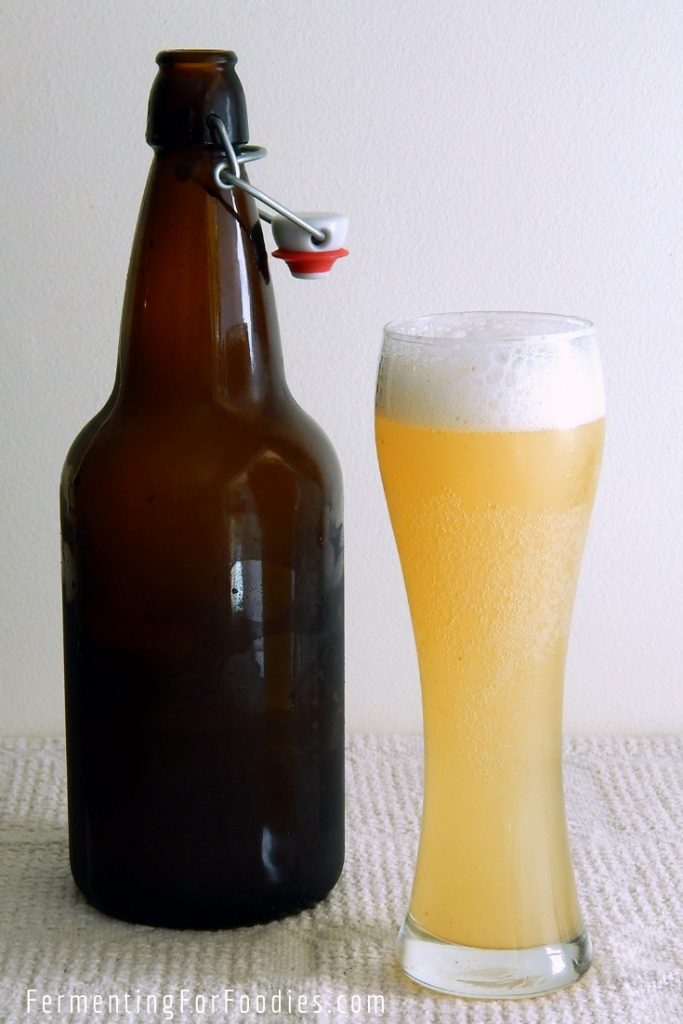
This recipe is courtesy of my husband. He brews several batches a year and loves to play with different flavors. So be sure to check out the section on flavor options. For anyone who is looking for a GF version, I developed a gluten-free kvass using puffed cereal.
What is bread kvass?
There are a lot of different types of kvass recipes, including beet kvass and cucumber kvass. However, bread kvass is a beer-like beverage made from toasted bread cubes.
It has a long history of being brewed in Eastern Europe and is likely a precursor to malted-grain beer. Even my husband’s teetotaling Russian/Ukrainian/Georgian ancestors brewed this slightly alcoholic beverage.
Best of all, it is simple to make at home as it doesn’t require any special tools or ingredients. It is also low in alcohol, so perfect for anyone trying to reduce their beer intake.
How to make bread kvass
Bread kvass is really easy. There are just three basic steps.
- Toast bread to create malted sugars (similar to malting grain for beer). Soak the toast cubes in water to extract the sugars.
- Strain the liquid from the bread. This liquid is fermented with sugar, yeast, and additional flavors.
- After the primary fermentation, the kvass is bottled and left to ferment for another 2-3 days to carbonate.
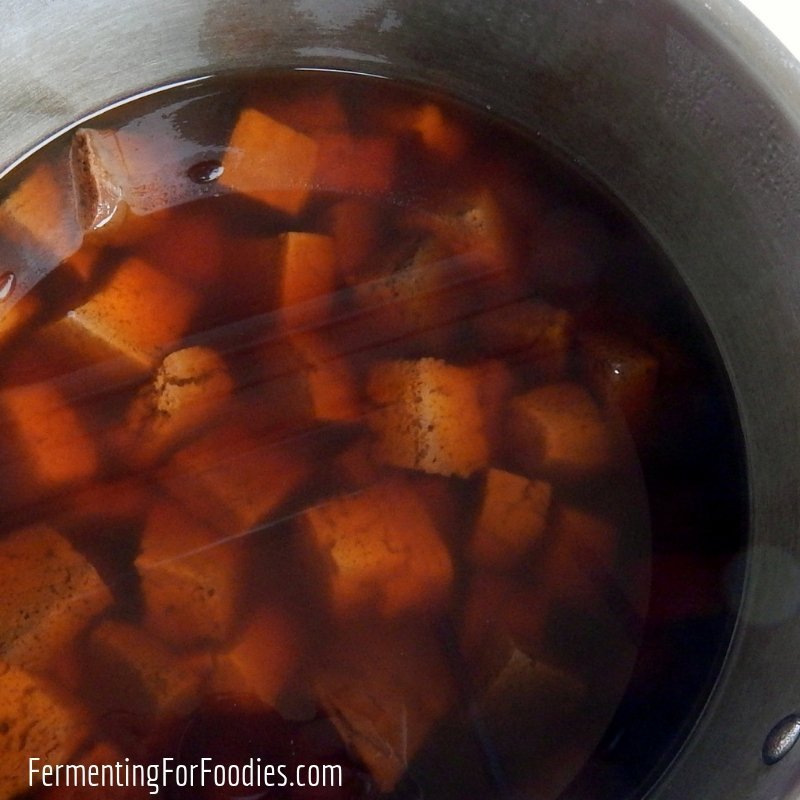
Flavors and Variations
There are several different ways to change the flavor of kvass. So it’s perfect for flavor experimentation!
1. Type of Bread
Rye bread is traditional, however, any kind of bread will work. My husband likes the caramelly flavor that comes from a nice loaf of dark rye. (See the photo above).
A loaf of white bread will result in a lighter beverage that is refreshing on a hot day. (See the photo below).
Usually, Brad makes kvass out of a mix of different bread scraps. He keeps a ziptop bag in the freezer and collects all the crusts and stale bread. When he’s collected enough bread scraps, he brews a batch of kvass!
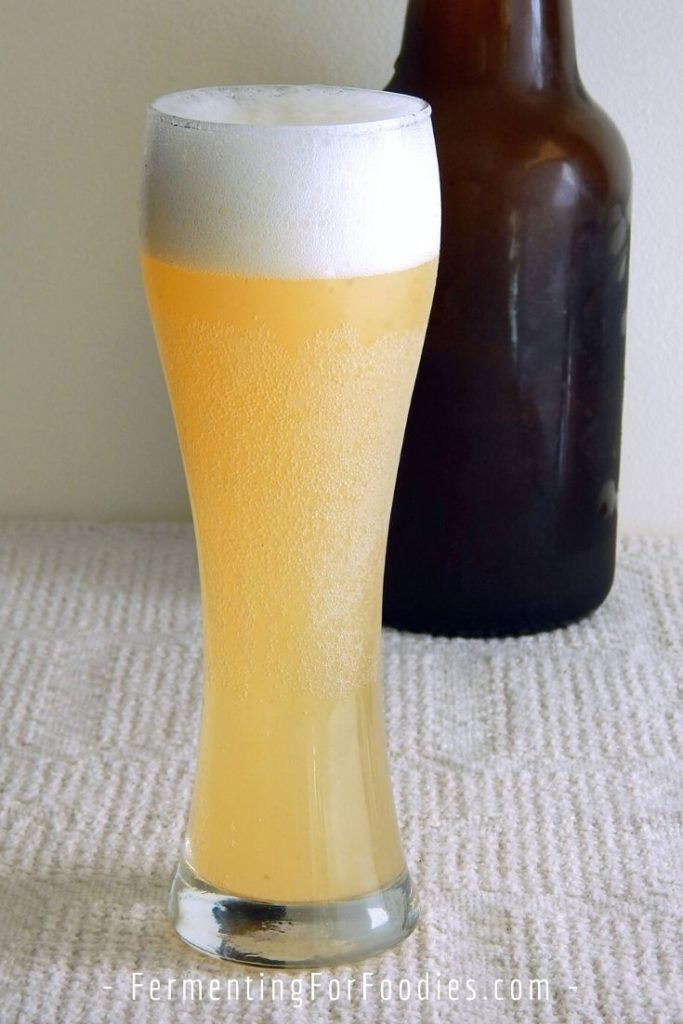
2. Types of Yeast
There are three different options for yeast. I’ve included instant bread yeast in the recipe because it’s easy and reliable. Here are more details about the other options:
- Bread yeast: The recipe is written for instant yeast but feel free to replace it with the same amount of fresh yeast. Bread yeast can ferment up to 8% ABV. However, I don’t recommend that as the flavor won’t be as good.
- Sourdough starter: To replace the yeast with sourdough starter, use 1 Tbsp of active starter. The resulting beverage will only be 0.5%-2% ABV. Because of the strains of bacteria in sourdough starter, the kvass will have a slightly unpleasant smell during the initial stages of fermentation. However, the smell and flavor will improve after bottling. Let it rest for one week in the fridge prior to drinking for the best flavor. The bacteria will give the kvass a unique taste, similar to sour beer.
- Brewers yeast: The yeast used to brew beer (not the dried supplement) can be used to make kvass. It is much more active, so only use 1/4 tsp.
Hops and other flavors
Bread kvass is much lighter and brighter than beer. It is perfect for fresh flavors. Here are a few options:
- Mint is traditional. Use a few sprigs of mint per batch.
- Add a handful of raisins, berries, or a few slices of apples for a fruity flavor.
- Lemon peel is refreshing.
- Hops will give it a beer-like flavor. It also acts as a preservative, improving longevity. Add 1 Tbsp of hops per batch.
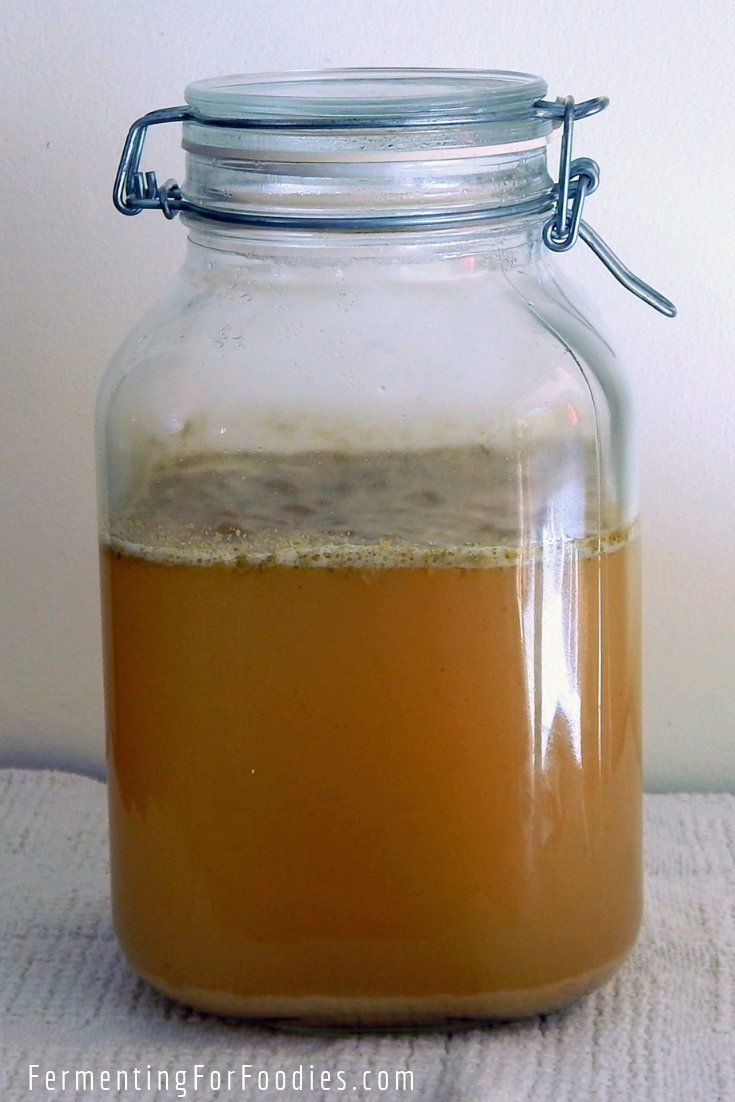
Traditional Bread Kvass
Bread kvass is an Eastern European drink that has a long history of being brewed at home. It is a sweet, sparkling, and lightly alcoholic drink. See the section above for flavor suggestions.
- Prep Time: 40 minutes
- Total Time: 40 minutes
- Yield: 3 litres 1x
- Category: Beverage
- Method: Fermentation
- Cuisine: Eastern European
- Diet: Vegetarian
Ingredients
- 1 lb of bread (see section above)
- 3 liters of water (chlorine-free)
- 2/3 cup of sugar
- 1 tsp instant bread yeast (see section above alternatives)
- Flavors (optional, see section above)
Instructions
- Cut the bread into crouton-sized cubes. Toast them in the oven at 350 F for 20 min. Toss halfway through to ensure even browning. The goal is to caramelize the sugars, so toast as long as necessary.
- Place the toasted bread cubes in a large bowl. Bring the water to a boil, and pour it over the bread. Let the bread soak for at least 4 hours (up to 24 hours). You want to extract the malted sugars into the boiling water.
- Strain liquid into a fermentation container (see notes for options). I recommend doing this by pouring the liquid through a cheesecloth-lined strainer, then wringing the wet bread to get all the liquid out.
- Stir the sugar and yeast into the liquid. Add any additional flavors at this point.
- Leave the kvass to ferment in a warm location to ferment for around 1 week. It will start to foam and bubble significantly after 6-12 hours.
- After one week, strain the kvass into plastic pop bottles or swing-top beer bottles and store them in the fridge. The kvass will continue to ferment and will build up pressure, so use bottles that can handle the carbonation. Pop the lid every few days to test the carbonation.
- It will be ready to drink after 3 days in the fridge. However, it will continue to ferment for another 1-2 weeks until all the sugars have been consumed by the yeast. At that point, it will no longer be sweet and it will have reached its full alcohol content. I recommend drinking it within the first 3 to 7 days for the best flavor.
Notes
- If you plan on drinking your kvass within 2 weeks of making it, you probably don’t need to worry about sanitizing. However, if you are keeping it any longer than that, I recommend sanitizing everything to ensure the best flavor.
- The kvass will bubble as it ferments, so either use a jar with a loosely-tightened lid (so the gas can escape), a carboy with an airlock, or a fido jar
for the initial ferment.

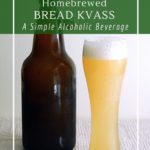
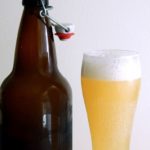
Just tried my sourdough kvass last night after waiting patiently for two weeks! It was really good. I could taste the mint and orange peel coming through quite nicely, but otherwise the flavour was almost like cider – light and slightly sweet. So cool to have made my own drink with nothing but some sourdough bread, sugar, yeast! Thanks for the recipe.
I’m glad it worked out for you! It is fun to make a quick and easy alcoholic beverage.
Thanks for the recipe, I hope you manage to see this comment since the article is from some time back but I wanted to know if normal white slice bread can be used if it is toasted to slightly burnt and can fruits be added as well? Say banana or apple just to give it a sweeter flavour (for someone who dislikes the sour taste) . Thank you
Hi! We make kvass with both white and rye bread. Just toast the white bread like you would with rye. I don’t recommend adding fresh fruit. However, adding raisins is traditional, and you can add other dried fruit for flavour. Regardless, kvass is quite a sweet drink (compared to beer). The only trick is to let the flavour develop to the right point (when it’s still sweet and sparkling and has a nice rounded flavour).
I made with my rye starter but didnt see bubling going on so the next day added half the yeast and still no bubbles
I know both are good with yeast
What do you think is wrong?
My bread was an all natural sour rye and water is from my well
How long did you wait? My husband makes sourdough rye all the time… but it takes a really long time to catch the culture. Like 5 days? Buckwheat starts really quick (2 days). I think it’s just the way the culture works. Also, if it was your first time fermenting sourdough, there might not be a very strong culture in your house. But if you start to do it regularly, it should get quicker to catch. I’m glad it worked with yeast!
Hi! The recipe looks good. I have also added 1tbsp of hops and 1tbsp of rye malt powder. One question. Can I use a fermentation plug, or should I close the lid tight? Thanks.
I would use a fermentation plug. It really carbonates, so you need to let the CO2 escape.
Thanks for the advice. I’ll post the result later 🙂
Great!
Hi, I’m going to try this recipe using a sourdough starter. My question is, you use a tbsp. of sourdough starter for 3 litres of water what will result in 0,5 to 2% alcohol. Does it means that if I use 2 tbsp. of sourdough starter for 3 litres will result in 4% alcohol? I’m not sure if this works like that… Thanks!
The alcohol levels aren’t related to the amount of yeast, just the type of yeast. Wild yeasts will die off at low alcohol levels. Bread yeast can handle a bit higher levels. Beer yeast strains can handle more, etc. Cheers!
Are you adding back water after letting your rye soak over night to bring back up to 3L? Wouldn’t there be a loss due to absorption from the bread? Should it be started at say 3.5L to compensate for loss?
We don’t add water back, however, we do wring out the rye bread, otherwise it does hold most of the water, much more than white bread does. However, if you wanted to add a bit of extra water you could. It would just dilute the overall flavour of your kvass. Enjoy!
Thanks for the answer 🙂
I’m thinking of co-pitching this with a farmhouse brewers yeast along with my sourdough yeast. I know those brewers yeast tend to take a bit longer to ferment, would you recommend longer than a week for the initial fermentation if I were to add brewers yeast as well?
I’m not sure about brewers’ yeast. Where I live brewers yeast is a nutritional supplement that doesn’t contain live yeast. However, brewing strains of yeast (for making beer) are perfect in this recipe. I would follow the recipe even if you use commercial yeast. This tastes best 2-3 weeks after brewing, then isn’t as nice as time goes on. Adding the sourdough starter will produce a funky smell early on, but don’t worry, it mellows out after 2 weeks! Enjoy!
Hello! Lovely recipe and I can’t wait to try it. I am a little bit confused about what exactly is “bread yeast” . I have my sourdough leaven, home cultivated, if you say that the Bread yeast resulted in more alcohol, would not mind trying that. Would dehydrated yeast work?
Thank you!
In Canada, bread yeast is instant dried yeast. Really, you can use any quick yeast for this recipe to add a bit of a boost. I also like the flavour better when it’s made with just bread yeast. The added bacteria from sourdough starter makes more of a sour flavoured kvass.
Thank you, Emillie!
What do you do with the leftover bread after straining? Is it all gluten at that point? It seems an awful lot to just toss.
We really wring out all the liquid, then we compost it. To be honest, we only make kvass with ends of bread that we’ve collected in the freezer. Hum… I wonder if it would taste good dried out in the oven, then added to homemade granola?
Is this work with your gluten free sourdough Sandwich type bread?
Posting a GF version is on my to-do list! (Just really busy working on a cookbook right now, so I haven’t had a chance). I think it will work, but honestly haven’t yet tried it. 🙂
With the wet bread I have made some pretty darn good crackers. I added back a little bit of flour (but possibly even that is unnecessary depending on how well it has been wrung), tiny bit of sugar, salt and because I really like carway and black jeera, I added those and some melted butter/oil. Spread evenly in a thin layer on a baking sheet (I put a drop of oil on that too, because the first batch got stuck to the sheet) and bake on low temperature (around 150°C) till it is done. Make sure the edges are not too thin because then they will burn. The result is rather delicious and reminds of Scandinavian crispbread. (I would add a picture but I don’t think it is possible through a comment.) Enjoy!
That sounds amazing! I will definitely try that then next time we make kvass. Love black jeera, yum! I would love a picture, but I have antispam software on my comments, so you’re right, it won’t work. 🙂 Thanks for sharing.
I made your sourdough kvass and I only yielded about a 1/3 of the liquid, is it possible I didn’t bake the bread enough?
Wow, it sounds like your bread really soaked up a lot of liquid. Feel free to press the bread with the back of a spoon to get more liquid out of it.
Thank you so much for putting the energy into a well written post, and all the comment(er)s and answers. I am just awakening to the necessity of cultures, and the incredibly satisfying vernacular that arises out of the axis where the word “culture” is simultaneously referring to populations of human beings and populations of microorganisms. I’m investigating the idea that kvass, kombucha, and other fermented beverages and foods might be the simplest, most easily accessible sources of natural vitamin B12, just for a start. Do you have any thoughts on this?
Cheers,
Karl
Hi Karl, Nutritional yeast and other yeast products are a good vegan source of B12. Thus any fermented yeast-beverage (sourdough kvass, kombucha, kefir, beer and will) will contain B12. It will depend on the amount of dead yeast in the beverage. So definitely a good idea to drink the cloudy dead yeast that settles at the bottom of the bottle if that’s what you’re looking for! Generally, drinks are bottled to remove the dead yeast, because it really doesn’t taste good. However, you can definitely drink it as a health shot. Or add it to savoury soups, etc. like nutritional yeast (though without the same flavour).
Two things to note: many store-bought fermented beverages wouldn’t contain the necessary yeast levels to provide a benefit. Live yeast makes fermented products unstable… as they continue to ferment, carbonate and potentially become alcoholic. So if B12 is your goal, then I recommend making your own. Good luck!
Do you use well feed sourdough starter or the discard?
It depends on how old the discard is. If there’s still some good life in it, you can use it. It should perk up with the added sugars.
Hi Emillie
I am a little confused about whether one may add fruit or not? You state in your recipe that slices of apple and berries may be added but later in the comments you say you don’t advocate adding fresh fruit.
I have just made coffee kvass with sourdough starter and bread, producing an evil looking brew that was surprisingly tasty. I wanted to try making something that didn’t look quite so scary.
Thanks
Thanks for point that out. I am in the process of editing all my posts. Hope to finish by June, and I’ll keep an eye out for this. I recommend dried fruit because it takes a lot more fresh fruit to flavour something (dried fruit has more flavour). Also, fresh fruit is more likely to be contaminated with wild yeasts or mold. However, experimenting is what fermenting is all about! I haven’t tried coffee kvass… sounds interesting. Mint or raisins are our favourite flavours. Enjoy!
Hi! I’ve been googling around for kvass recipes and yours seem good and very straightforward and I like the facit that you describe how to do it wirh sourdough. Moat otger recipes seem to use either baker’s or brewer’s yeast while I’m much more interested in wild fermentations such as sourdough. Your photo of the finished product looks amazing as well!
However, since I’ve never brewed anything before, let alone kvass, I’m a bit confused/curious about certain things in the kvass making-process. I hope that you have time to answer my questions briefly.
1. You don’t ferment the kvass ‘in-bottle’ in room temperature at all. Why is that? In a lot of youtube-videos where they brew probiotic sodas and the like, they often ferment their brew in bottles in room temperature foe some time before putting the bottles in the fridge. Will I get a higher carbonation if I let it stand in room temperature for some time after bottling?
2. There’s quite a lot of sugar in your recipe. What’s the reason for that? Is it for the sweet taste or to achieve a higher alcohol content when the fermentation is complete? And aren’t the sugars in the rye bread enough to ferment the kvass on its’ own? What would happen if I cut down on the sugar?
3. The fermentation time prior to bottling iin your recipe is quite long. Hy is that? Do you know roughly how high the alcoholic content is right when you bottle the kvass? I don’t want a very alcoholic drink and I want some sweetness left. Will I get rhat with this long fermentation time? Or would I ave to bottle it earlier than you did?
4. If I were ro flavor ot with mint, which sounds delicious by the way, when would I put in the mint? Right from the start and let it ferment together with the liquid or just before bottling? Also do you use fresh mint leaves or dried? What variety of mint have you used? Peppermint, spearmint or some other kind? Chocolate mint perhaps?
Hi Max,
Glad to help you with your first brew! Using a sourdough starter will result in a very funky flavoured kvass. It mellows out after bottling, but will always be a bit unusual. (Just want you to know what to expect!) As for your questions:
1. I find kvass to carbonate very quickly. Some ferments, like ginger beer, need to sit out for a few days to carbonate. But kvass will become explosive if left to ferment like that! However, sourdough starter (instead of beer yeast or bread yeast) may require a day or two at room temperature. It’s easiest to test if you use plastic bottles. If you’re using glass bottles, then pop them open once a day to test carbonation. I recommend popping them open over a sink and be prepared to cap them quickly if they start to erupt!
2. The sugar feeds the yeast to carbonate the beverage. If you cut down on the sugar it might not get as bubbly as you want. It’s amazing how much sugar yeast will consume. The sweetness will depend on how long you ferment. So if you find it too sweet, leave it for another day or two and taste it again.
3. Using sourdough starter you won’t be able to achieve an alcohol content above 4% (and even that high is unlikely). The first ferment allows the yeast to do most of the work prior to bottling. Then the dead yeasts are filtered out with bottling (leaving just a few left alive to carbonate the beverage). Dead yeasts don’t taste good… so the longer first ferment improves the flavour.
4. Put the mint into the first ferment. Use fresh mint, whatever flavour you wish. (I’ll update that now for clarity! Thanks!)
Cheers, Emillie
Indeed, thanks so much for this recipe and all the comments. My dark sourdough ryebread is toasting right now. Thanks also Sarka for the cracker recipe. I initially wanted to use sourdough starter for the kvass as I have plenty, the bread feels like such a waste! I especially baked dark rye for this, I never have leftovers… Trying this kvass now with bread so I have an indicator, will test with only starter after. So the only question that I’m left with is: how can you use only one spoon of starter for 3 litres of kvass? How does that compare to almost half a kilo of bread? Thanks and greetings from Amsterdam!
Hi Leanne,
I really recommend using instant yeast for your starter as the flavour of sourdough starter will result in something that tastes more like sour beer. However, in either case, you only need a small amount of starter (whether it’s sourdough starter or instant bread yeast) because the beverage will ferment for 10 days or up to 20 days depending on when you drink it. So there’s plenty of time for the yeast to bubble and consume the sugars. Speeding up the process with more yeast just doesn’t result in as good a flavour. In contrast, when making bread, you typically only ferment for up to 24 hours.
Enjoy! Emillie
It’s my first time brewing anything and I am on day four in the Carboy. I used dark rye and followed your instructions as best as I could. I’m still seeing bubbles, but was wondering if it is supposed to clarify or stay cloudy? I just want to make sure I’m on the right track before I bottle it. Thank you very much for the recipe, I’m very excited to try this.
Since beer and wine brew for longer, the yeast will settle out before bottling. However, this is a quicker ferment, so expect some cloudiness. Try to remove any settled solids when bottling. (But don’t worry if you can’t…) Cheers!
Thanks for the quick response! How would you recommend going about removing the solids? Would this be a simple as keeping the siphon away from the bottom? Or is there a way to strain it that you recommend?
My siphon has a little stopper (about 1/4 inch high) at the bottom that keeps it out of the solids. That’s enough for me. If your siphon pulls right from the bottom of then try to keep it out of the solids. Not no need to strain or anything. A bit of solids in your bottle is fine. Enjoy!
Hey! Thanks for the recipe! Just a clarification on the sanitation: it says if you plan to drink within in 2 weeks, no need to sanitize…but is this two from when the when the it’s complete (i.e. the end of this process, when ready to drink) or 2 weeks from the beginning of the process (i.e. 1 day soak + 1 week fermentation + 3 days in the fridge = 11 days till consumable). Just wondering if I have 3 days to drink it before I’m in the danger zone or if I have 2 weeks to from the end. Thanks again!
Two weeks from the time it’s complete. Basically, if you’re not planning on storing it for any length of time, you’re probably fine. Enjoy!
It’s only been 4 days and the fermentation has slowed to a complete stop, ( not more bubbles in the airlock). Is it done? Or should I go the rest of the 7 days? I live in a warm area and the house can get up to 78 inside. Would this speed it up?
Temperature definitely plays a role in the speed of fermentation. If it doesn’t seem to be fermenting as much, then definitely bottle it. Usually, fermentation slows… maybe to a point where you don’t notice it. So hopefully it will still carbonate in the next few days. Cheers, Emillie
There are other ferments and beers that have the second fermentation for carbonation where they add sugar to the bottle. Do you think that will work?
You’re right! Beer does prime for carbonation. However, I think it’s unlikely that your yeasts truly used up all the sugars. Maybe taste a little bit before bottling? If it’s not sweet, then feel free to add 1 tsp of sugar per 750 mL bottle. (My usual beer priming amount). Good luck!
I have tried to make this recipe a couple of time and have not had success yet. I’m assuming I’m not using the correct fermentation device. I tried to get a better jar to use and this time my kvass after the week of fermentation has a dark and clear top and a cloudy and lighter bottom within the jar. Could you tell me what may be causing this?
Is it just the color that makes you think it’s not working? Likely the cloudiness at the bottom of the jar is the settled remainder of the bread. If it’s thicker than mine (in the photo just above the recipe) that’s probably because your cheesecloth has a loose weave and more of the solids are straining through. Is there another reason why you think it’s not working? Cheers!
Hey I don’t happen to have any 3L gars, besides the obvious halting of ingredients how can I adjust the recipe for a single 1.5L gar?
The first few times we made kvass, we used a large soup pot for the initial brew. However, here are the ingredients for a half-batch: 1/1 lb of bread, 1 1/2 liters of water, 1/3 cup of sugar 1/2 tsp instant bread yeast. Enjoy!
Would the brewing time change at all?
Nope, brewing is based on the proportions of ingredients. However, temperature also is a key factor. (Warm speeds things up, cool slows them down.) Cheers!